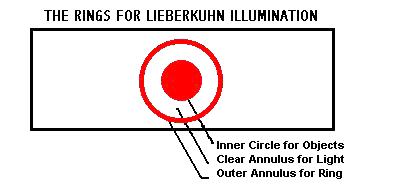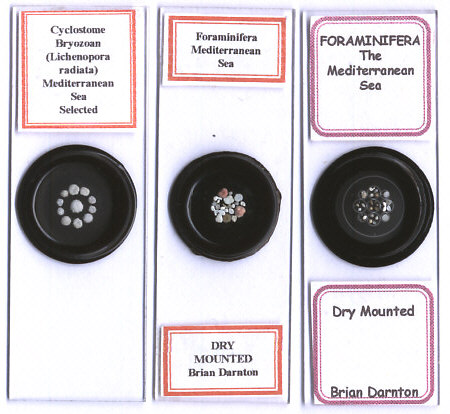INTRODUCTION
Dry mounting is one of oldest methods
of preparation to be used in microscopy. It is particularly suitable for
calcareous marine objects like Foraminifera and sea mats as well as for
chemical crystals, clothing fabrics and desiccated objects such as minute
insects. During the vintage years they were very often characterised by
their complexity as well as their beauty. There have been many variations
during the last 150 years, but there are some minimum guidelines.
They must be strong enough to withstand handling.
Watertight enough to resist moisture penetration
Clear enough to allow entry of reflected light and to be viewed under the microscope.
Deep enough to protect the objects but not so deep as to restrict the use of medium power objective lenses.
Must have a background that enhances the object aesthetically.
Must use an adhesive that is as invisible as possible when dry.
Must be sealed when quite dry to avoid fungal growth or the condensation of water.
Objects for very low powers may be covered by thick glass. Laid Foraminifera were often covered by 3 X 1 inch one mm thick glass slide.
SPACER RINGS
The use of aluminium rings of various dimensions has proved to be trustworthy in the construction process, particularly during the past 50 years. Other metals tend to be too heavy. They are simpler to produce than the glass rings of the Victorian age. They can be parted from tubular aluminium in a lathe at any thickness but 1 mm is a useful general purpose dimension, but up to 2 mm can be cut for exceptional objects like crystal clusters. Three types can be currently bought from Northern Biological supplies (UK) which are 19 mm in diameter.
The following method evolved as a
rapid no nonsense, no frills system.
HUMBROL MATT PAINTS
Humbrol toy paint has long been a useful material in microscopy as well as modelling. Some time ago I discovered that in addition to cloaking my lack of neatness, the paints can also act as a quite strong permanent adhesive. If a metal ring is stuck onto a ring of paint on a glass surface the shearing power required to dislodge it when dry, is much greater than that required to move a ring stuck with regular conventional adhesive.
Many members who enjoy the photography
of microscopic objects may prefer colour rather than the traditional black.
A colour or grade of grey may give a better technical performance particularly
when automatic photographic exposure is used. A low density of white objects
on a jet black background may result in overexposure.
THE RING OF PAINT
First the 19 mm circle of matt paint
is applied to the 3" X 1" slide whilst rotating on a turntable. Before
use, the paint must be really well stirred and shaken until the liquid
is well mixed. Do give at least 5 minutes for the process. Then it's a
good idea to let it settle for a few minutes before using. If the painted
circle is even when dry, then that is a good paint to use. Some colours
have large particles that can be graded by the hairs of the paintbrush
during application and these colours must be discarded. The matt reds and
the blue colours do not normally produce unsightly particle spirals. If
a No. 2 brush is used then one brush full is enough for each ring. Thick
paint can shrink and wrinkle leaving an unsightly surface. The first circle
is allowed to dry for up to 6 hours and then a second circle is applied
and it is onto this surface that the aluminium ring is lowered. It's not
a bad idea to leave the work overnight to make sure that it is thoroughly
dried out. The aluminium cannot be stuck to the first coat because as the
paint dries a disproportionate amount is drawn under the ring by capillary
action, leaving a paint deprived annulus inside the ring.
RINGS FOR LIEBERKÜHN ILLUMINATION
This method employs light from below the stage and a hollow mirror reflects light down onto the objects from a curved surface around the objective lens. It usually takes the form of a perforated metal cup that clips around the objective lens. The under surface is usually anodised in chromium or nickel. A temporary Blu-tak Lieberkühn surfaced with silver foil may be constructed in a few minutes. In order to construct this type of preparation only a very small circle of paint 12 mm in diameter is applied centrally in order to leave a clear annulus through which light can travel. An outer annulus around this, is required to secure the ring but this may be ringed with the same paint. Again 2 coats of paint are required as the central circle must be thick enough to allow no penetration of light or the effect is lost. During use with a Lieberkühn a full cylinder of light is required from the substage source.

GUMMING THE OBJECTS
Gum tragacanth is one of the best
gums for adhesion. It is used fresh and is ready after a few minutes of
mixing with pure water. The strength can only really be found by trial.
The required concentration depends upon the weight of particles to be stuck.
Nowadays I use as strong a solution as possible that is not visible when
dry and this is achieved by practice. In the wet state over strong glue
can be detected, by the appearance of blobs of mucilage in the fluid and
this can be thinned out with the careful application of more water. An
excess of fluid may be reduced by the careful application of a small ribbon
of filter paper. Objects like Foraminifera may just as well be laid in
some sort of order rather than at random. They may be placed in rows, a
cruciform pattern, or in a centric formation. Grading for size also enhances
the appearance of the finished article.
DRYING OUT THE CELL
Although I have a perfectly good
desiccator bought from a retired dentist, I prefer to use a desk lamp to
thoroughly dry out the cell contents using very limited heat from a distance
of 18 inches. It's much quicker and quite reliable. Excessive heat however
can severely damage the paint surface.
SEALING THE CELL
gold size can be run from a brush
onto the upper surface of the ring. When this is almost dry but still tacky
an hour or so later, the coverslip can be cleaned and pressed down, to
be ringed with gold size a few hours later. Toluene is an excellent solvent
if the gold size is too hard. The next day a ring of black shellac or gloss
paint can be applied. For the novice gloss paint is quite adequate, shellac
requires experienced management. After the very first seal is applied its
important to maintain an absolutely even temperature or the contraction
of air in the cell can draw in the slightly fluid gold size. Labelling
must of course not be neglected.
ALTERNATIVE PAINTS
Other paint will work well and matt paint used for car touch-up work has one or two advantages. The solvent is very volatile so the work is speeded up but it can be difficult to mix in the tube provided.
Some of these tubes contain a ball
bearing to aid mixing but this may not always be included. In that case
shaking and repeated insertion and withdrawal of the built-in brush also
effects good mixing.
CONCLUSIONS
Dry mounts are very suitable for beginners because processing is usually fairly rapid but it is not without pitfalls. Sealing in moisture and allowing in moisture after desiccation, are probably the worst faults, but from the evidence of surviving preparations it is a good method for a wide variety of objects and much under used and under rated by modern mounters.
All comments to the author
Brian
Darnton are welcomed.
Table of Production.Mix and shake a suitable matt Humbrol paint for at least 5 minutes.
Apply a 19 mm ring of matt paint to the centre of a 3X1 blank slide with a No 2 brush on a turntable.
Allow 6 hours to dry.
Apply a second ring 19 mm in diameter.
Lay the 19 mm aluminium ring onto the wet paint
Allow 6 hours to dry. Prepare some gum tragacanth in water.
Lay the microscopic objects onto the painted surface
Allow the gum time to dry under the distant effect of a desk lamp
Apply a thick ring of Goldsize on the top and outer edge of the aluminium ring
Allow the Goldsize to become tacky but not dry: then lower 19 mm coverslip.
Allow an overnight for drying. Apply a peripheral protective ring of Goldsize.
After 6 hours ring with shellac or gloss paint. Avoid direct heat during the drying period.
Dry off the Shellac/paint in a warm room Label and store dry.
Materials Required
Matt Humbrol Paint. And Humbrol Paint solvent
No 2 Paintbrush
Aluminium rings 1.5 mm
Goldsize, with Toluene solvent
Turntable
A selection of dry mounted slides prepared by the author.
